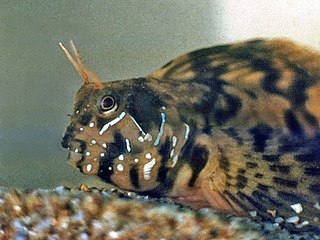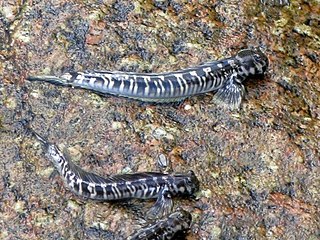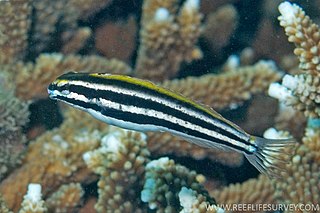
Atrosalarias fuscus, also known as the dusky blenny, brown coral blenny or black blenny, is a species of marine fish in the family Blenniidae.

The sphinx blenny is a species of combtooth blenny, and the only species in the genus Aidablennius. It was described by Achille Valenciennes in 1836, originally under the genus Blennius, and was later reassigned under "Aidablennius" by Gilbert Percy Whitley in 1947. It is a subtropical blenny known from Morocco, in the eastern Atlantic Ocean, and also from the Mediterranean and Black Seas. Sphinx blennies inhabit shallow, rocky waters in the littoral zone, with sunlight exposure. They feed primarily on benthic algae, weeds and invertebrates. Sphinx blennies can measure up to 8 centimetres (3.1 in) long in total length.
Alloblennius is a genus of combtooth blennies found in the western and northeastern Indian Ocean.
Alloblennius anuchalis is a species of combtooth blenny in the genus Alloblennius. It is a tropical blenny found in the western Indian ocean, around Mauritius and Oman. Males can reach a maximum standard length of 2.4 centimetres. The species is oviparous.
The jugular blenny is a combtooth blenny found in the western Indian Ocean. Klunzinger originally placed this species in the genus Blennius. It is a tropical, marine and freshwater blenny which is known from the Gulf of Aqaba and the Red Sea, in the western Indian Ocean. Male jugular blennies can reach a maximum standard length of 5 centimetres. The blennies are oviparous.
Alloblennius parvus, the dwarf blenny, is a combtooth blenny, from the subfamily Salarinae, of the family Blenniidae. It is a tropical blenny which is known from the western Indian Ocean, and has been recorded swimming at a depth range of 6–10 metres. Dwarf blennies have pale bodies with a dark spot between their first and second dorsal spines. Males have a dark colouring beneath their heads and around their pectoral fins, and can reach a maximum standard length of 2.6 centimetres. The blennies are oviparous.

Alticus anjouanae is a species of combtooth blenny in the genus Alticus. Fourmanoir originally placed this species in the genus Andamia. It is a tropical blenny known from Comoros, Seychelles, and Réunion, in the western Indian Ocean. Males can reach a maximum total length of 7.6 centimetres (2.99 inches). Blennies in this species are oviparous and form distinct pairs when mating. They feed primarily off of benthic algae and weeds.

The Pacific leaping blenny, also known as the leaping rockskipper, is a species of combtooth blenny in the genus Alticus. The blennies are oviparous, and form distinct pairs when mating. Males can reach a maximum total length of 8 centimetres. These fish feed primarily on benthic algae, which they consume by scraping off rocky surfaces.

The Kirk's blenny is a species of combtooth blenny in the genus Alticus. It was described by A. Günther in 1964, originally as a member of the genus Salarias. It is a tropical blenny which is known from the Red Sea, Mozambique, Réunion, the Persian Gulf, and India, in the Indian ocean. Kirk's blennies inhabit waters near the shore, and often spend time out of the water. They are able to breathe air when on land. They are oviparous, and form distinct pairs when mating; they also guard their eggs. They can reach a maximum total length of 11 centimetres, and feed primarily off of benthic algae.

Alticus monochrus is a species of combtooth blenny in the genus Alticus. It is a tropical blenny found in the western Indian Ocean including the Comoros Mozambique, Madagascar, the Seychelles and the Mascarene Islands. It can reach a maximum total length of 10 centimetres. The blennies feed primarily off of benthic algae. They are oviparous.
Alticus montanoi, Montano's rockskipper, is a species of combtooth blenny in the genus Alticus. It is a tropical blenny, and is known from the South China Sea, in the western Pacific Ocean. The blennies are oviparous, and form distinct pairs when mating. They feed primarily off of benthic algae. The specific name honors the collector of the type, the French ethnologist Joseph Montaro.

The leaping blenny, also known as the jumping blenny, is a species of combtooth blenny in the genus Alticus. There is some uncertainty as to whether it was first described by J.R. Forster in 1788 or B.G.E. Lacepède in 1800, although Fishbase currently accredits it to Forster. It was originally described as a member of the genus Blennius.
Alticus sertatus is a species of combtooth blenny found in coral reefs in the western central Pacific Ocean around the nations of Fiji and Tonga.
Alticus simplicirrus, the Marquesan rockstripper, is a species of combtooth blenny found in the central Pacific ocean, around the Marquesas Islands. This species reaches a length of 3.7 centimetres (1.5 in) SL.
Litobranchus fowleri, Fowler's rockskipper, is a species of combtooth blenny found in coral reefs in the western Pacific ocean. It can reach a maximum length of 3.5 centimetres (1.4 in) SL. This species is currently the only species in its genus. The specific name hours the American ichthyologist Henry Weed Fowler (.

Meiacanthus lineatus, the lined fangblenny, is a venomous species of combtooth blenny found in the Great Barrier Reef in the western Pacific Ocean. This species grows to a length of 9.5 centimetres (3.7 in) TL.

Ecsenius pictus, known commonly as the white-lined comb-tooth in Indonesia and the pictus blenny in Micronesia, is a species of combtooth blenny family Blenniidae.
Ecsenius niue is a species of combtooth blenny in the genus Ecsenius. It is found in coral reefs around Niue Island, in the eastern central Pacific ocean. It can reach a maximum length of 3.1 centimetres. Blennies in this species feed primarily off of plants, including benthic algae and weeds. The specific name refers to Niue Island, so far the only location from which E. niue is known.
Coralliozetus rosenblatti, the Spikefin blenny, is a species of chaenopsid blenny found in coral reefs in the eastern central Pacific ocean. It can reach a maximum length of 3.5 centimetres (1.4 in) TL. This species feeds primarily on zooplankton. The specific name honours the ichthyologist Richard H. Rosenblatt (1930-2014) of the Scripps Institution of Oceanography.

Enneapterygius atrogulare is a species of triplefin blenny in the genus Enneapterygius. Although it is known as the blackthroat triplefin in the United Kingdom, it is also known as the ring-scale triplefin, black triplefin, eastern white-barred threefin, ringed triplefin, eastern Australian blackhead triplefin or the saddled triplefin in Australia. It is a subtropical, non-migratory blenny found in coral reefs in the western Pacific Ocean, around Australia and Tonga. Blackthroat triplefins swim at a depth range of 0–5 metres, and both juveniles and adults feed primarily on benthic algae, weeds, and invertebrates. Male E. atrogulare can reach a maximum length of 5 centimetres.










